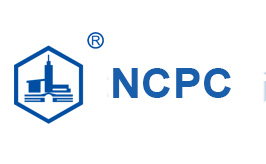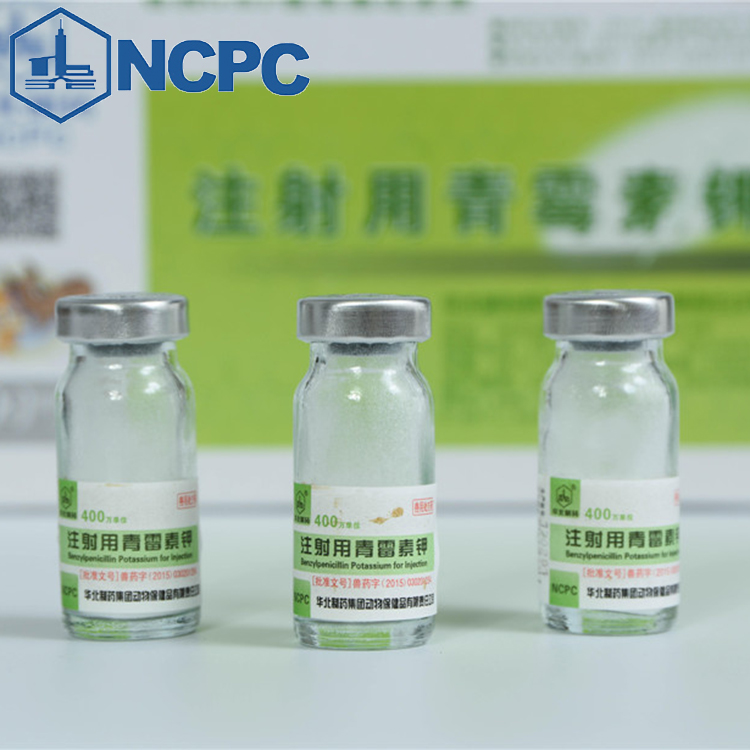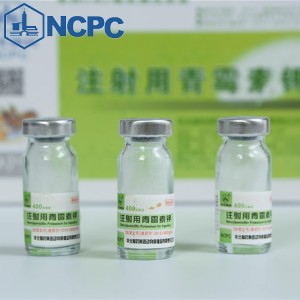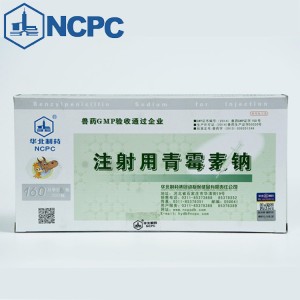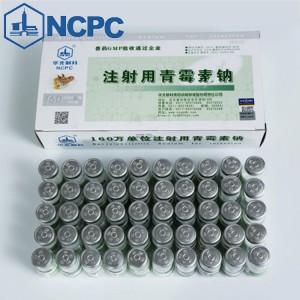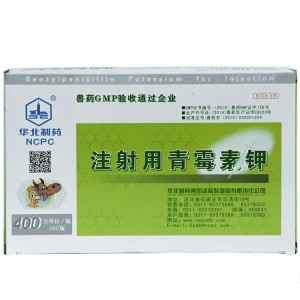|
Composition |
Each vial contains penicillin sodium 1.6 MIU/4.0 MIU |
|
Apply To |
Pig,Poutry,Aquatic animals |
|
Characters |
White or almost white sterile powder. |
|
Indication |
This product is mainly for Gram-positive bacteria infection, also used for actinomycetes and leptospirosis and other infections. |
|
Usage and dosage |
to penicillin sodium. Intramuscular injection: an amount of weight per 1kg, horses, cattle 10,000 to 20,000 units; sheep, pigs, foals, calves 20,000 to 30,000 units; dogs and cats 30,000 to 40,000 units; birds 50,000 units. 2 to 3 times a day, once every 2 to 3 days. Before use, add sterile water for injection to dissolve. |
|
Superiority |
Penicillin sodium for injection
[Main components] penicillin sodium
[Characters] This product is white or almost white sterile powder.
[Pharmacological effects]
Pharmacodynamics Penicillin is a bactericidal antibiotic, antibacterial activity is strong, its antibacterial mechanism is mainly to inhibit bacterial cell wall mucins synthesis. Sensitive bacteria in the growth stage are highly fragmented and the cell wall is in the stage of biosynthesis. Under the action of penicillin, the synthesis of the sticky peptide can not form the cell wall, and under the action of osmotic pressure, the cell membrane ruptures and dies. Non-growth and reproduction of bacteria, this time without the need for cell wall synthesis, penicillin can not afford bactericidal effect, should not penicillin such “breeding season bactericide” and inhibit bacterial growth and reproduction of “fast bacteriostatic agent” (such as fluorobenzene Nico, tetracyclines, erythromycin, etc.). The latter makes the bacteria in a state of growth inhibition, resulting in penicillin can not play a role.
Penicillin is a narrow-spectrum antibiotic, mainly to a variety of Gram-positive bacteria and a few Gram-negative bacteria. The main sensitive bacteria Staphylococcus aureus, Streptococcus, Erysipelomyces, Corynebacterium, Clostridium tetani, actinomycetes, Bacillus anthracis, spirochetes and so on. Mycobacterium, mycoplasma, chlamydia, rickettsia, nocardia, fungi and viruses are not sensitive.
Pharmacokinetic penicillin sodium salt absorbed rapidly after intramuscular injection, peak blood concentration reached 15 to 30 minutes, intramuscular injection of plasma concentration remained above 0.5μg / ml for 6 to 7 hours. Penicillin can be widely distributed throughout the body tissues and can enter the fetal circulation, with higher concentrations of kidney, liver, lung, muscle, small intestine and spleen; lower levels of bone, saliva and milk. In normal cerebrospinal fluid concentration of only 1% to 3% of plasma concentration, inflammation concentration of cerebrospinal fluid up to 5% to 30% of plasma concentration. The concentration of penicillin in milk can be 5% to 20% of the plasma concentration. Intramuscular injection of penicillin, the first few hours can be a lot of absorption, the milk can maintain the antibacterial concentration to a considerable length of time. It has been reported that 100 000 units of penicillin aqueous solution are infused into the milk chamber, which retains 4.26 units / ml to 24 hours in the milk.
Penicillin a small part of the liver metabolism, most of the prototype excretion. In normal circumstances, 50% to 75% of renal excretion, of which 90% through the renal tubular secretion, due to the rapid discharge, so eliminate the body faster. Penicillin plasma protein binding rate of about 50%. Short half-life, small differences between species, all livestock half-life of 0.5 to 1.2 hours. Apparent distribution volume is also small, usually 0.2 ~ 0.3L / kg, higher plasma concentrations, tissue concentrations lower.
[medicine interactions]
⑴ penicillin and aminoglycoside combination can increase the concentration of the latter in the bacteria, showing a synergistic effect.
⑵ macrolides, tetracyclines and amide alcohols and other fast-acting bacteriocides on the bactericidal activity of penicillin interference, should not be combined.
⑶ heavy metal ions (especially copper, zinc, mercury), alcohols, acids, iodine, oxidants, reducing agents, hydroxyl compounds, acidic glucose injection or tetracycline hydrochloride injection can destroy penicillin activity, prohibit compatibility.
⑷ amine and penicillin can form insoluble salts, can delay the absorption of penicillin, such as procaine penicillin.
(5) penicillin sodium aqueous solution and some drug solutions (such as chlorpromazine hydrochloride, lincomycin hydrochloride, norepinephrine tartrate, oxytetracycline hydrochloride, tetracycline hydrochloride, B vitamins and vitamin C) should not be mixed, or can produce turbidity, Floc or sediment.
[Role and purpose] β-lactam antibiotics. Mainly used for Gram-positive bacteria infection, also used for actinomycetes and leptospirosis and other infections.
[Usage and dosage] to penicillin sodium. Intramuscular injection: an amount of weight per 1kg, horses, cattle 10,000 to 20,000 units; sheep, pigs, foals, calves 20,000 to 30,000 units; dogs and cats 30,000 to 40,000 units; birds 50,000 units. 2 to 3 times a day, once every 2 to 3 days.
Before use, add sterile water for injection to dissolve.
[Adverse reactions]
⑴ mainly allergic reactions, most livestock can occur, but the incidence is low. Local reactions manifested as injection site edema, pain, systemic reactions urticaria, rash, severe cases can cause shock or death.
⑵ for some animals, penicillin can induce gastrointestinal infections.
[Precautions]
(1) penicillin sodium soluble in water, aqueous solution is unstable, it is easy to hydrolysis, hydrolysis rate increases with temperature and acceleration, so injection should be prepared before use. Necessary preservation, should be placed in the refrigerator (2 ~ 8 ℃), can be stored for 7 days, at room temperature can only be stored for 24 hours.
⑵ should understand the interaction with other drugs and incompatibility, so as not to affect the efficacy of penicillin.
⑶ high-dose injection may be hypernatremia. On renal dysfunction or heart failure patients will have adverse consequences.
⑷ treatment of tetanus should be combined with tetanus antitoxin.
[Off-drug] 0 days; abandonment of milk 72 hours.
[Specifications] Calculated by C16H17N2NaO4S 0.96g (1.6 million units)
[Storage] Sealed, kept in cool dark dry place.
[Validity] 2 years.
[GMP Certificate Number] (2014) Veterinary Drug GMP Certificate No. 150
